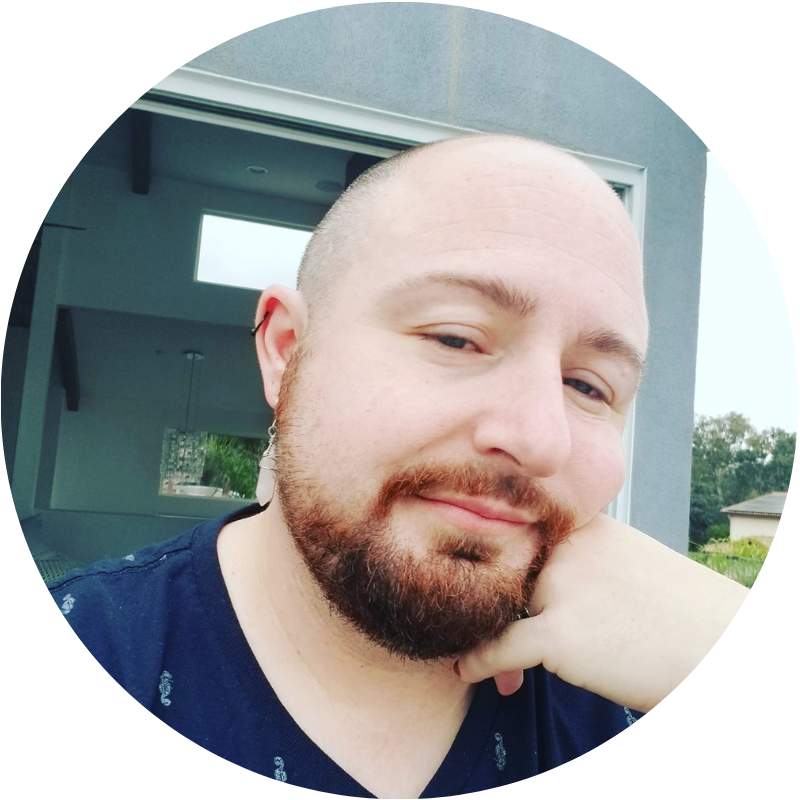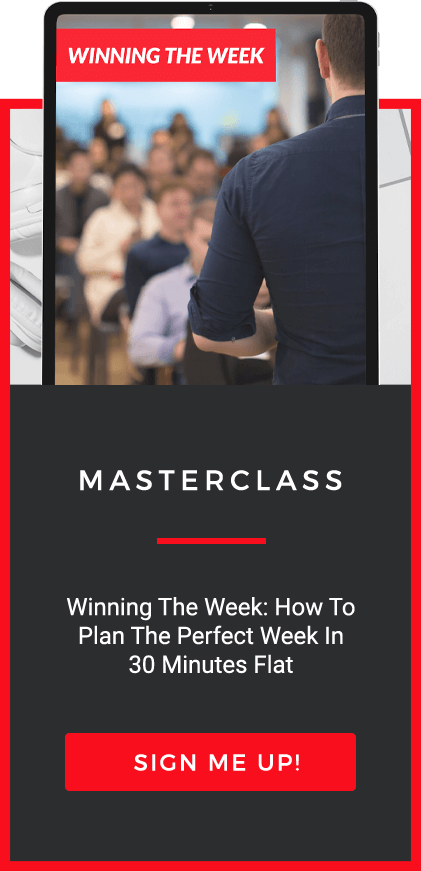This is a guest blog post, written by our amazing Lifehack Coach Aiden McFarland!
I’ve spent a lot of my career feeling behind. I’ve always had trouble focusing, I dance with deadlines often, and I’m a hardcore perfectionist.
But then I found Demir and Carey’s Lifehack Method productivity system. I joined as a student a few years ago, and what I started to learn and implement literally changed my life. Then I trained to become a Lifehack Assistant Coach…and the student became the teacher!
In this post, I’ll share some of the components of the Lifehack Method that have worked particularly well for me as I learn how to thrive with ADHD.

A brief overview of ADHD
Despite the name being Attention Deficit Hyperactivity Disorder, there is so much more to it! Our brains can struggle with focus, time management, following through, memory, forming habits and more.
ADHD affects executive function, organization abilities, and emotions. Something that may seem quite simple and straightforward to someone with a neurotypical brain can be a monumental hurdle for a person with ADHD.
Because our brains don’t produce enough dopamine naturally, we try to find it externally. If what we are doing excites us, we’re more likely to do it, and keep doing it. If it does NOT excite us, well…it becomes a struggle.
It’s not that we don’t WANT to do the things that we need to do (trust me, sometimes we REALLY WANT to do those things)…
But our brains fight us, leading us down rabbit holes of hyperfixation and making us forget that hours have gone by and keeping us from doing the things that we need to do.
When things don’t get done, it’s not due to laziness. And no amount of grit or willpower can fully counteract the weird way our brains are wired.
I have always struggled with this – from elementary school to my time in the traditional workforce. I often found myself overwhelmed and driven by anxiety and panic to get things done. After a ton of trial and error, I discovered early on in adulthood that the more systems I put into place, the more I could be on track at work.
Working remotely and being able to create a schedule for myself that I know works has helped a lot.
The rest? Skills I learned from the Lifehack Method.
Let’s dive into some of the most important tools from the Lifehack Method that I use day in and day out.

Skill #1: Embrace Radical Imperfection
I’ve heard variations of “show yourself grace” and “let go of perfectionism” for years. But I still thought, “that’s fine for everyone else, but not for me. I DO have to be perfect!”
Demir, the Lifehack Method Head Coach, practices radical imperfection openly and honestly with his clients. Seeing his example, I was able to let go of perfectionism and stop judging myself so harshly for procrastination.
I learned that it’s not my fault my brain doesn’t work like others, but it is my responsibility to find ways to cope in a world that isn’t designed for me. I take ownership of what I can control and recognize what I really have no control over at all.
There’s a difference between letting ADHD be a reason you struggle, and turning it into an excuse for why you can’t get things done. After all, some of the most productive people in history have ADHD, like Richard Branson, Leonardo da Vinci, and Bill Gates.
Accepting that difference is the key to allowing some of the self-inflicted shame and guilt to fall away.
Some days, embracing radical imperfection means I say “my brain is fighting me too much today, I’m going to do the bare minimum and then try again tomorrow”… and not feel guilty about it.
Skill #2: Weekly Pre-Planning
Weekly Pre-Planning is a core practice we lead our Lifehack Tribe members through every Friday, where we:
- Review the past week, to understand where your time went and what you got done
- Look ahead to the upcoming week to realistically plan out what you have time to get done
This practice was revolutionary for me. It was one of those “I didn’t know what I didn’t know” situations.
Sure, I had a calendar with appointments, and I had a to-do list (okay, several to-do lists). But I wasn’t reviewing them weekly. I was trying to trust a broken system (my own brain) to know what to do and what to prioritize.
The first few weeks of running the Lifehack Method Winning The Week Method™️, it took a looong time. But every week, I honed my process. Today, my weekly pre-planning is a fine-tuned machine.
I have recurring time blocks in my calendar for regular tasks (like eating, work blocks, and household chores) which I can slide around as needed. I use Google Calendar, including layers and color coding, for visual clarity.
If something doesn’t fit into my schedule, I know it won’t get done and I can prepare for that.
One of the biggest wins I’ve had is understanding the concept of UUW (Unplanned, Unwanted Work). Essentially, it means blocking off a few hours each week to allow for the inevitable fact that things probably will go sideways.
This allows me to have grace with myself, even when despite my best efforts, things just don’t get done.
Here’s a quick video on some of the other elements of the Winning The Week Method™️ that I follow:
Skill #3: Body Doubling
Body doubling is having another person around while you work on something.
The other person doesn’t have to be doing the same thing, or assisting directly, or even talking to you. Their presence alone helps anchor you to your task.
Just having someone around can help you start a task, stay focused, and finish it.
Our Lifehack Tribe membership includes premium access to a service called FocusMate, which is totally genius because it’s like 24/7 access to virtual body-doubling!
(I am curious if the people behind FocusMate are familiar with or even have ADHD!)
When I’ve got another person in the room with me, either physically or virtually through FocusMate, it’s amazing how much it boosts my productivity.
Skill #4: Time Tracking
A common ADHD issue is time blindness. Minutes can feel like hours and hours can feel like minutes.
If I’m doing something I enjoy, hours can go by without me taking a break for anything – even eating. Sometimes I don’t perceive time passing, and I don’t notice a deadline inching closer until it’s literally on top of me (or worse, has past!).
When you first start working the Lifehack Method, we ask you to track your time (down to 30 minute increments) for 2 weeks.
The first time I tracked my time, it was very confronting! But seeing the data in front of me helped me see why I frequently felt off, overwhelmed, or lost.
Getting clear about where my time was going helped me start making better decisions with my time, start time blocking my days more, and setting timers to make sure I don’t lose track of time entirely.
Here’s a quick video from Demir on how time blindness can keep you stuck:
Skill #5: Using the Life Map
Since my brain goes a million miles an hour, I also struggle with having too many great ideas.
If my brain had it his way, I’d launch a clothing line, take on 20 new clients, and solve climate change this week!
That’s why the process of creating a Life Map – a document that helps you identify your most important long-term goals, and breaks them down into bite-sized tasks – was so life-changing for me.
The Life Map was massive in terms of getting me something that had been elusive for most of my life:
Clarity.
I am clear on what I want, why I do what I do, and what is actually the priority. I have never had that luxury before. It’s been game changing for my brain.
Now, I am radically clear on my priorities. And I can stay radically clear on my priorities.
The Life Map is such an important skill that we give a hands-on monthly workshop on it in our Lifehack Tribe membership.
Skill #6: Mastering a Task Manager
At Lifehack we often refer to online task managers (we use Asana) as “your second brain.”
On a recent training call, Demir said something that stuck with me. The question was:
Is it worth it to use something like Asana if I have ADHD?
His answer was:
“I get clients all the time who have ADHD, my answer is then you need this more!
Think of it as your second brain! It helps you remember everything that you can’t remember. It gives you the right thing at the right time. If you have ADHD, you need to master a task manager.”
Asana has been essential for my productivity. It makes up for the fact that at any given moment my own brain might be either twenty competing ideas and thoughts yelling over each other, or that old dial up noise when you would log into the internet.
My new motto is, if it’s not in Asana, it will not happen (at least not when it’s supposed to!) End of story.
For a visual example of how to use Asana, check out this short video from Carey, our Asana Mastery coach:
Where I “break the rules”
Lifehack Method teaches us to do the Big Thing (the looming project, the thing with the greatest long-term benefit) FIRST in our day, and in our week.
However, that doesn’t always work for me! Even if it’s something I want to do, my brain will literally fight me on it.
When that happens, I reverse that attitude and do the smaller (maybe crappier) things first.
This works in two ways. First, doing those small things (even if I hate them) and crossing them off my list gives my brain dopamine!
Second, if I wait on those things, it will actually make me build them up more in my brain and make it worse and make it more of a struggle to do them.
Getting all the little stuff crossed off and done gives me the momentum and satisfaction that I need to go into my Big Thing with even more excitement to complete it.
So, am I perfect now?
Ha! No, of course not. I’ve learned that perfection is not the end goal, because it’s not a necessary element for me to have a tremendously successful life.
In fact, here I am the evening before this blog post is due, and I’m still looking at a jumbled list of bullet points and thoughts. Procrastination isn’t always eliminated, but it can be improved. After all, you’re reading this finished blog post on time and on schedule!
So, please keep in mind:
- The Lifehack Method is not some magic pill that magically makes my ADHD disappear, and I’m not 100% “on it” at all times. What Lifehack has done is give me a way to function effectively in a society that was not designed for the way my brain works (and in fact, which my brain actively fights AGAINST).
2. I am one person. Certain things work for me, but your mileage may vary. ADHD or not, our brains are all unique and there is no 100% one-size-fits-all approach. My advice is to use what works, tweak as needed, and discard what doesn’t. Especially for those of us who are neuro-diverse, it’s important to find what works for your brain. Don’t try to force it to fit what a “normal” brain can do. That’s a recipe for disappointment and failure (believe me, I’ve tried).
I hope you are coming away with some valuable takeaways and nuggets!
If you’ve been looking for a community of people (ADHD or otherwise) that can support you in becoming the most productive, relaxed, and next-level version of yourself, I invite you to join me in Lifehack Tribe. It’s like a gym, but for your productivity.
Honestly, this article is just scratching the surface of all the ways the Lifehack Method has changed the game for me. I didn’t even dive into the importance of systems…digital detoxes… morning & evening routines… Someday Lists… and so much more. Maybe I’ll cover those in a Part 2 blog post.
Thank you SO much for reading!
To your success,
Aiden McFarland
Lifehack Method Assistant Coach


